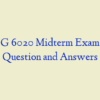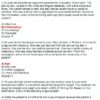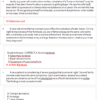Description
NSG 6020 Week 3 Quiz Multiple Choice
- Which of the following is consistent with good percussion technique?
- You are at your family reunion playing football when your uncle takes a hit to his right lateral thorax and is in pain. He asks you if you think he has a rib fracture. You are in a very remote area. What would your next step be?
- Which of the following is not considered an adventitious sound heard in the lung fields?
- A mother brings her infant to you because of a “rattle” in his chest with breathing. Which of the following would you hear if there is a problem in the upper airway?
- A sixty-year-old baker presents to your clinic, complaining of increasing shortness of breath and nonproductive cough over the last month. She feels like she can’t do as much activity as she used to do without becoming tired. She even has to sleep upright in her recliner at night to be able to breathe comfortably. She denies any chest pain, nausea, or sweating. Her past medical history is significant for high blood pressure and coronary artery disease. She had a hysterectomy in her 40s for heavy vaginal bleeding. She is married and is retiring from the local bakery soon. She denies any tobacco, alcohol, or drug use. Her mother died of a stroke, and her father died from prostate cancer. She denies any recent upper respiratory illness, and she has had no other symptoms. On examination, she is in no acute distress. Her blood pressure is 160/100, and her pulse is 100. She is afebrile, and her respiratory rate is 16. With auscultation, she has distant air sounds and she has late inspiratory crackles in both lower lobes. On cardiac examination, the S1 and S2 are distant and an S3 is heard over the apex.
- Which of the following anatomic landmark associations is correct?
- A patient with long-standing COPD was told by another practitioner that his liver was enlarged and this needed to be assessed. Which of the following would be reasonable to do next?
- A twenty-one-year-old female presents to your clinic complaining of shortness of breath and a nonproductive nocturnal cough. She states she used to feel this way only with extreme exercise, but lately, she has felt this way continuously. She denies any other upper respiratory symptoms, chest pain, gastrointestinal symptoms, or urinary tract symptoms. Her past medical history is significant only for seasonal allergies, for which she takes a nasal steroid spray but is otherwise on no other medications. She has had no surgeries. Her mother has allergies and eczema, and her father has high blood pressure. She is the only child. She denies smoking and illegal drug use but drinks three to four alcoholic beverages per weekend. On examination, she is in no acute distress and her vital signs are: T 98.6, BP 120/80, pulse 80, and respirations 20. Her head, eyes, ears, nose, and throat examinations are essentially normal. Inspection of her anterior and posterior chest shows no abnormalities. On auscultation of her chest, there is decreased air movement and high-pitched whistling on expiration in all lobes. Percussion reveals resonant lungs. What is your diagnosis?
- On examination of a young child you notice that he or she has a noisy breathing, barking, “seal-like” cough. What would your diagnosis be?
- When crackles, wheezes, or rhonchi clear with a cough, which of the following is a likely etiology?








